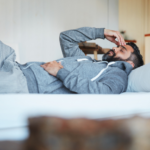Severe throbbing pain, intense nausea and extreme sensitivity to light and sound — yep, migraine is way more than a headache.
Migraine is a complex neurological disorder that affects over 4.9 million Australians, and worldwide it’s the second leading cause of years lived with a disability.
On top of the huge impact migraine can have on a person’s life, there are a lot of misconceptions about the condition that lead to stigma.
So, we’re covering what you need to know about migraine, its symptoms, causes and what you can do about it.
Some of the language used to describe migraine can minimise the condition and lead to misconceptions about the disease. You might notice that we’ve used the term ‘migraine’ rather than ‘a migraine’ here. It’s the proper terminology used by the medical community because migraine is a whole condition rather than a one-off experience. For example, you wouldn’t say you have ‘an epilepsy’.
What is migraine?
Migraine is a complex neurological disorder with a range of symptoms, the main one being moderate to severe headache. Migraine can begin in childhood, but often starts in your 20s or 30s.
What are the symptoms of migraine? What does a migraine attack feel like?
Migraine symptoms and severity differ from person-to-person. Some people might experience a migraine attack once a year, others might have several a week.
Migraine symptoms usually occur over three or four phases. Being able to identify and treat a migraine attack early on can help you prevent or minimise symptoms.
1. A ‘premonitory’ phase
In the first few hours to days you might experience non-painful symptoms like yawning, tiredness, thirst, needing to urinate often and difficulty concentrating.
2. An ‘aura’ phase
Only one-third of people with migraine experience aura, which involves sensory or other brain symptoms like vision problems, language problems and strange smells. It occurs immediately before or at the beginning of headache.
3. A moderate-to-severe throbbing headache
This is usually experienced on one side and typically gets worse with head movement. It is often accompanied by feeling sick, and sensitivity to light, sound, touch and smells.
4. A ‘postdromal’ phase
Also known as ‘migraine hangover’ — symptoms of the postdromal phase include tiredness, difficulty concentrating and sensitivity to noise.
5. An ‘interictal’ phase
This occurs in between attacks of migraine when there are no symptoms. This can be very short for people with chronic migraine.
“If you have frequent headaches that are painful or distracting then it could be a migraine,”
“Men should realise that frequent headaches is common but it’s not healthy, and that they should see their doctor about it. If they’re not happy with the results they get from the doctor then they should see a neurologist, because there are safe [treatment] options that are effective.”– Carl Cincinnato, Director of Operations at Migraine & Headache Australia.
What causes migraine in men?
We don’t fully understand the causes of migraine. We do know there is a strong genetic contribution to migraine — people whose parents or siblings have migraine are more likely to have it themselves.
Scientists also think sex hormones play a large role in migraine as they affect women more than men.
Impact of migraines
From days off work to a strain on your relationships — migraine can take a significant toll on your life.
“It really permeates all aspects of life in social and professional domains, and it ultimately affects your quality of life,”
“What we see happens with a lot of people that are working with migraine is that they are forced to hide it and that hiding the migraine leads to isolation and you’re less likely to get support from people around you if they don’t know that you have it, which is the sad truth.”– Carl Cincinnato, Director of Operations at Migraine & Headache Australia.
The condition can also affect your overall well-being with links to blood vessel disease, asthma, allergies, epilepsy, chronic pain, restless leg syndrome, depression, anxiety and post-traumatic stress disorder and other mental health problems. The psychological impact can be particularly challenging.
“It’s not surprising when you have a condition that’s poorly managed, that very few people talk about, with the stigma and the isolation that goes along with it,”
“After a period of time of trying different treatments, and getting all the side effects, and not getting great benefits, you can see how people lose hope. You can also see how it causes anxiety when you have this unpredictable neurological condition that results in very painful attacks that can make you vomit or sick and take away your vision for periods of time.”– Carl Cincinnato, Director of Operations at Migraine & Headache Australia.
What are common migraine triggers?
Men report stress (69%), bright light (63%) and sleep deprivation (60%) as the most common migraine triggers, but these kinds of studies that rely on human recall aren’t the most reliable.
If you’re experiencing migraine, it can help to keep track of when you get a migraine attack and the conditions before it started. Chat with your doctor about any patterns you notice.
There is no test to diagnose migraine but a doctor will consider your symptoms, your medical history and your family’s medical history. Getting a diagnosis can help you get appropriate treatment that could improve your quality of life.
How can you treat migraine?
There is currently no cure but there are several treatments for migraine that can prevent or lessen its impact. Don’t just battle through the pain, chat to a doctor about your options.
“Often you need a comprehensive plan, particularly if you have frequent migraine, that involves acute treatment and prevention, which is really important to distinguish,”
“Acute treatment is what you take at the start of an attack, prevention is what you do or take to stop the attack from occurring in the first place.”– Carl Cincinnato, Director of Operations at Migraine & Headache Australia.
“There are a lot of different options for people and there are also combinations of options,” Cincinnato. “Making those choices in partnership with your doctor is the best way to give yourself a good chance of either remission from frequent migraine or to bring your condition under control.”















